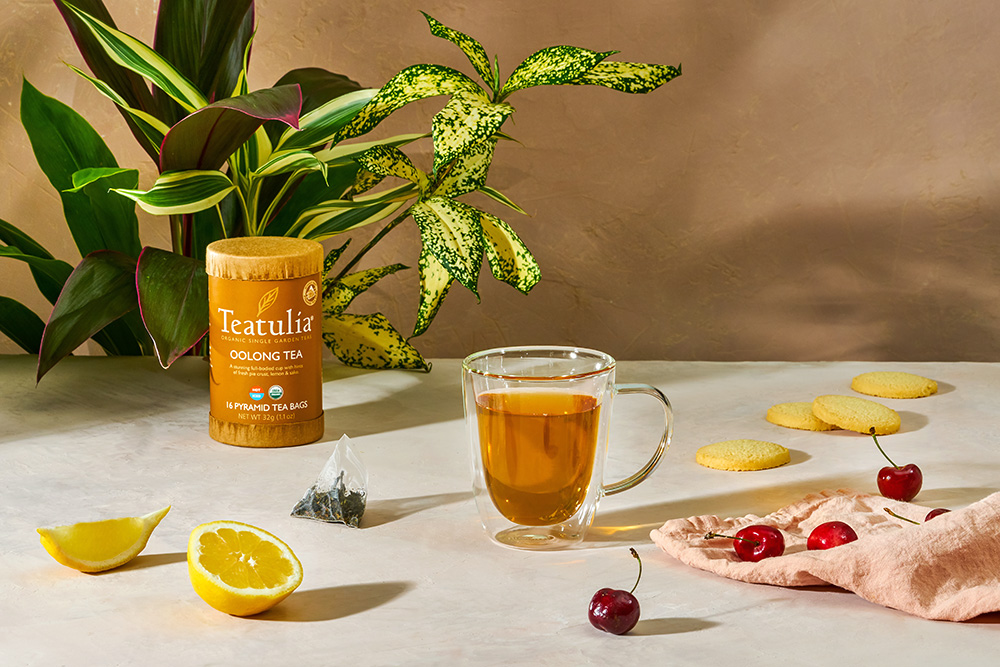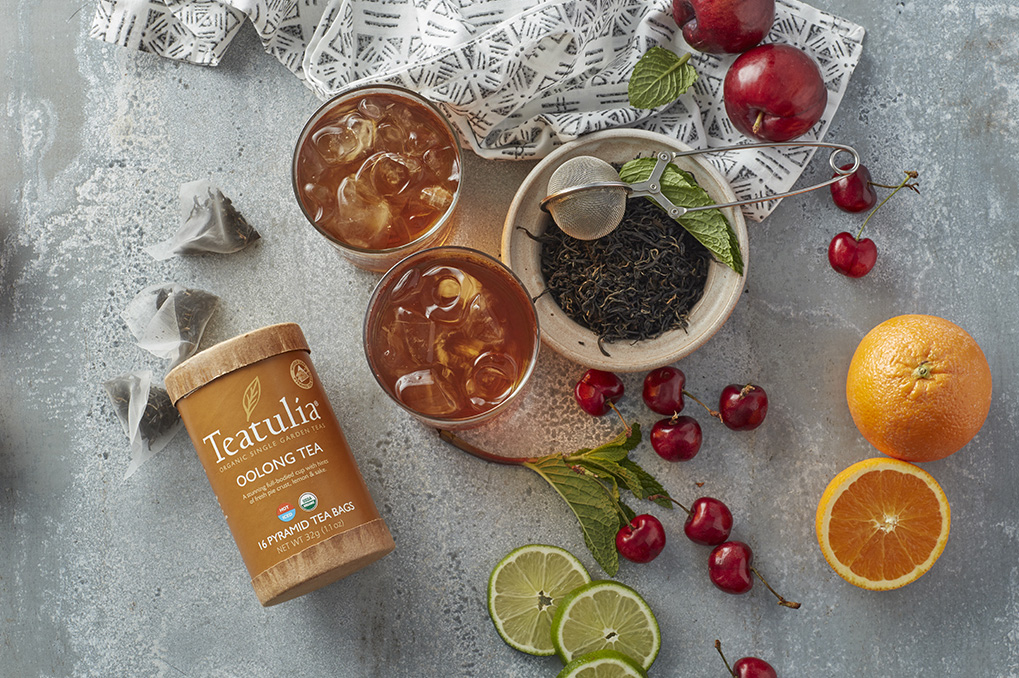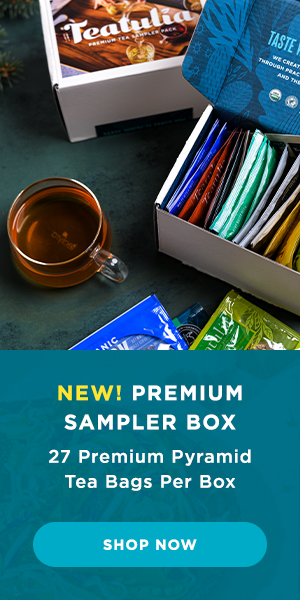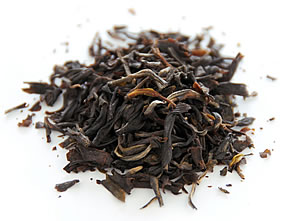Oolong is neither a black tea nor a green tea; it falls into its own category of tea. Yet an oolong may end up with more black tea characteristics or more green tea characteristics depending on the direction the tea master takes in the processing of the tea.
Oxidation: Black tea is allowed to fully oxidize during processing, giving the tea leaves their dark color and rich malty aroma they’re known for. Green tea is barely oxidized at all, so the leaves keep some of their original green leaf color and fresh-picked flavor. Oolong tea falls somewhere in between and is often described as a partially oxidized tea. But oxidation levels in oolong can vary from 8% to 80% depending on the production style of the tea master. Which is why the flavor profile of some oolongs may lean more toward a fresh green tea (less oxidized) and others toward a malty black tea (more oxidized).The biggest difference between oolong tea and black or green teas? Oxidation and shape.
Shape: Oolong teas are traditionally rolled, twisted or curled into tight balls or thin strands. These artisanal shaping techniques depend on the traditions of the tea master making the tea. Rolling is an important aspect of oolong processing that alters the appearance, color and aroma of the final tea leaves. Depending on how and when the leaves are rolled during processing, the tea master can subtly alter the entire direction of the tea’s final flavor.
Oolong tea origins
Oolong represents a true artisan mastership of tea processing. The appearance, shape and flavor of an oolong tea can vary wildly depending on the region where it’s grown and how it’s processed. The origins of oolong are claimed in both China and Taiwan and the tea is still highly revered in both countries today.
One story claims that the Chinese bestowed the name “wulong” or “black dragon” upon the big dark tea leaves, which were heavily oxidized and twisted into shapes that happened to resemble the mystical Chinese dragon. Another story tells a tale of a tea farmer named Wu Liang (later shortened to Wulong) who discovered the oolong style of tea by accident. The farmer was distracted after a long day of tea picking and upon returning to his withering tea leaves he discovered they had already started to oxidize. No matter which story you believe, it is true that the most famous Chinese oolongs are grown in high mountainous regions over rocky terrain and in cool weather. It is the unique geography and harsh environment that gives these oolongs the rich flavor they are famous for.
Taiwan’s most famous oolongs are traditionally less oxidized (10% to 40%) and therefore tend to be greener in color and lighter in flavor than Chinese oolongs. The styles of oolong produced across the country vary just as much as the styles of wine that come out of France. Some oolongs are rolled into small tight balls, while others are twisted into long leafy strands. Some grow in remote mist-covered mountains, while others thrive in temperate bamboo-forested foothills. Some are plucked in spring for a flowery herbaceous flavor, while others are picked in winter and roasted for a hearty woodsy flavor.
While the most famous oolongs originated in China and Taiwan, different styles of oolong are being made in other parts of the world today. India, Sri Lanka, Japan, Thailand and New Zealand are just a few of the countries producing some of the world’s oolong teas.
How oolong tea is made
To understand oolong, you really need to understand tea processing. All tea—black, green and oolong—starts out from the same Camellia sinensis tea plant. The difference in what ends up in your teacup depends on many factors, including the variety or cultivar of the tea plant, the terroir of the plant (the characteristics of the geography, climate and culture), and how the tea leaves are processed after they are picked.
The flow of Teatulia®’s oolong tea processing looks something like this:

Withering:
Fragile just-picked tea leaves are first intentionally bruised by tossing or shaking them. This is an important step to help initiate the oxidation process that will give oolong tea leaves their ultimate flavor. The leaves are then laid out to dry in the sun for several hours so they “wither” and loose some of their moisture content. Withering softens the tea leaves, making them flexible and supple so they won’t break during the important step of rolling and shaping the oolong tea.
Cooling:
The tea leaves need time to rest and cool down from the heat of the sun withering before the rest of the processing takes place. As they cool, they begin to wilt and flatten. As they start to change shape, they are ready to be rolled.

Light Rolling:
It’s the rolling process that helps the tea leaves develop their unique appearance and flavor profile. As the wilted leaves are lightly rolled, they are further bruised. Bruising breaks the cell walls of the leaves, releasing the enzymes and essential oils that will alter the flavor of the leaves. Rolling further exposes the chemical components of the tea leaves to oxygen and spurs on the oxidation process. Rolling also helps define the shape the tea leaves will take.

Oxidizing:
Oxidation is a chemical reaction that alters the flavor of the tea leaves and helps the processed tea develop its ultimate appearance and color. How long the tea leaves are allowed to oxidize, or be exposed to oxygen, will determine the type of tea the leaf will become. Oolong teas vary in levels of oxidation, anywhere from 8% to 80%, and therefore vary in color and flavor depending on the goals of the tea producer.

Roasting:
Once the tea leaves are oxidized to the desired level, heat is applied to halt the oxidation process and to start drying out the leaves. Roasting applies heat and also lends important flavor characteristics to the final oolong tea.

Final Rolling:
A key characteristic of any oolong is its shape. This final rolling of the roasted and partially dried tea leaves defines the final appearance and flavor of the tea.
Drying:
The shaped oolong tea leaves are then left to dry. It is important to completely reduce the moisture content in the tea leaves so they can be stored without spoiling.

Hand Sorting:
Once the tea leaves have fully dried, they are visually sorted into various groups of similar size and color to create different lots of like teas. Each lot of tea receives a different industry grade that rates how the tea visually looks depending on how much whole leaf, broken leaf or unopened tea buds end up in the lot.
For more information about how different teas are processed, visit our How is Tea Made? page.
Tasting oolong tea
Because oolong tea is oxidized at varying levels depending on the processing technique of the tea master, its flavor can range from light to full bodied, floral to grassy, and sweet to toasty. The color of the leaves and the hue of the brewed tea can also vary from green to golden to brown.
The differences between the types and flavors of oolong teas are often compared to the differences between fine wines. While all wine comes from a grape, it is the combination of the variety of the grape, how and where the grape was grown and the artisanal style of the wine maker that ultimately determines how the wine will taste in your glass. Even within one country’s wine industry, different flavor profiles can be found in different types of wine.
Speaking of fine wine, a wine sommelier (a trained wine professional) tasted Teatulia’s oolong tea and provided this description of the flavor profile:
"There is a nose of fresh pie-crust, egg shell, lemon and sake in here. This is a stunning cup. If vintage Domaine Huet, a white wine from the Loire made from a crazy grape called chenin blanc, were a tea, it would be this. Fascinating. Stunning. Wow."
Sounds a lot like a wine review, doesn’t it?
Given its origins, oolong tea is hugely popular in Asia. In fact, just as there are wine competitions in California, Italy or France, there are oolong competitions across Asia to honor the artisanship of oolong tea producers. Teas may be judged on everything from the shape and appearance of the dry and wet leaves to the color, aroma and taste of the brewed tea. Competition winners may win a “world’s best” title, prize money or the chance for their artisan tea to be picked up by worldwide distributors. But for many oolong producers, competition is a way to demonstrate their honor and passion for the life they’ve dedicated to the art of oolong tea.


Caffeine content in oolong tea
There are many factors that can determine caffeine levels of any beverage brewed from a caffeinated plant, including the variety of the plant, how the plant was processed and how the beverage was brewed. The caffeine content in an oolong tea generally falls somewhere between a black tea and a green tea. A lightly oxidized oolong may have lower caffeine levels (similar to a green tea) and a highly oxidized oolong may have higher caffeine levels (similar to a black tea). But this can vary depending on how the tea plant was cultivated and how the oolong tea was processed. It’s always best to ask your tea vendor about caffeine levels specific to the tea you’re purchasing if you are concerned about caffeine intake.
Buying and storing oolong tea
Storing an oolong tea properly will ensure that your tea will remain fresh as long as possible. It’s always a good idea to buy tea from a reputable company that can tell you when and how the tea was processed and packaged as well as provide storage tips to help prolong the life of the tea.
It is important to ask the tea vendor about the oxidation levels of your oolong tea. A more oxidized oolong tea will more shelf stable than a less oxidized one. Your oolong tea won’t really go “bad”, but it can get stale if it sits around too long. If stored properly in a cool dark place, in an opaque airtight container, away from light and moisture, and far from pantry items like coffee and spices that can leach flavor into the tea leaves, oolong teas can last anywhere from six months to two years before they should be used or replaced.
For more information about how to best care for your tea, visit our How to Store Tea page.
Preparing oolong tea
Because oolong teas vary wildly in their oxidation levels and processing techniques, many oolongs will have different ideal brewing temperatures and steeping times. While it’s best to ask your tea vendor for brewing instructions specific to the tea you purchased, here are a few general oolong tea brewing tips:
- Use fresh, pure, cold filtered water. Spring water is best.
- Because styles of oolongs vary so much, steeping temperature and time can vary as well. Generally, oolongs are steeped anywhere between 180 and 200 degrees for 60 seconds to 3 minutes.
- If you don’t have an electric kettle with temperature control, just remember that at sea level water simmers at 190 degrees and boils at 212 degrees. The boiling temperature drops about a degree for every 100 feet in altitude increase.
- Most oolong teas are designed to steep multiple times. Each steeping unfurls the rolled or twisted leaves just a little more, revealing even more layers of the flavor profile intended by the tea master who created the tea. It is not uncommon to get 3 to 5 infusions out of a high-quality oolong.
- Avoid over steeping your oolong tea. Many oolongs are designed to taste best with multiple short infusions. Taste your tea after the recommended steeping time and then decide if you’d like it to steep a little longer.
- If your oolong tea came with specific recommendations for brewing, use those. But using about 2 grams of loose leaf tea per 8 oz. cup of water is a safe bet.
- Cover your oolong tea while it steeps to keep all the heat in the steeping vessel.
- Tea producers spend a lot of time mastering the art of oolong tea. To best appreciate the handcrafted flavors of an oolong tea, try sipping it plain with no additives like milk or sugar.
Sources: Oolong via Wikipedia
Specialty Tea Institute
The Story of Tea: A Cultural History and Drinking Guide by Mary Louw Heiss and Robert J. Heiss, 2007


